The icon above is contemporary, available from https://www.trinitystores.com/artwork/christ-desert

Crete, c. 1550
Submit this question to the internet, and almost everybody will say: No, of course not. How could we possibly know that? All we know is that (if He existed, a few will say…) He was a First Century Jew.
I think they’re wrong. I think the answer is: Yes, we do know what Christ looked like. Of course it can’t be proved. (What can?) But I think the evidence is all for it. I think our icons – though, of course, intended to be images of Christ and the saints glorified – are based on His actual appearance. I want you to think about it, too.
Let’s begin positively.
What we can know for sure about His appearance
A few Posts back, someone commented about a Black Lives Matter protester who said he wanted to destroy “white Jesus” and “white Mary”. That was obviously intended to sound offensive.
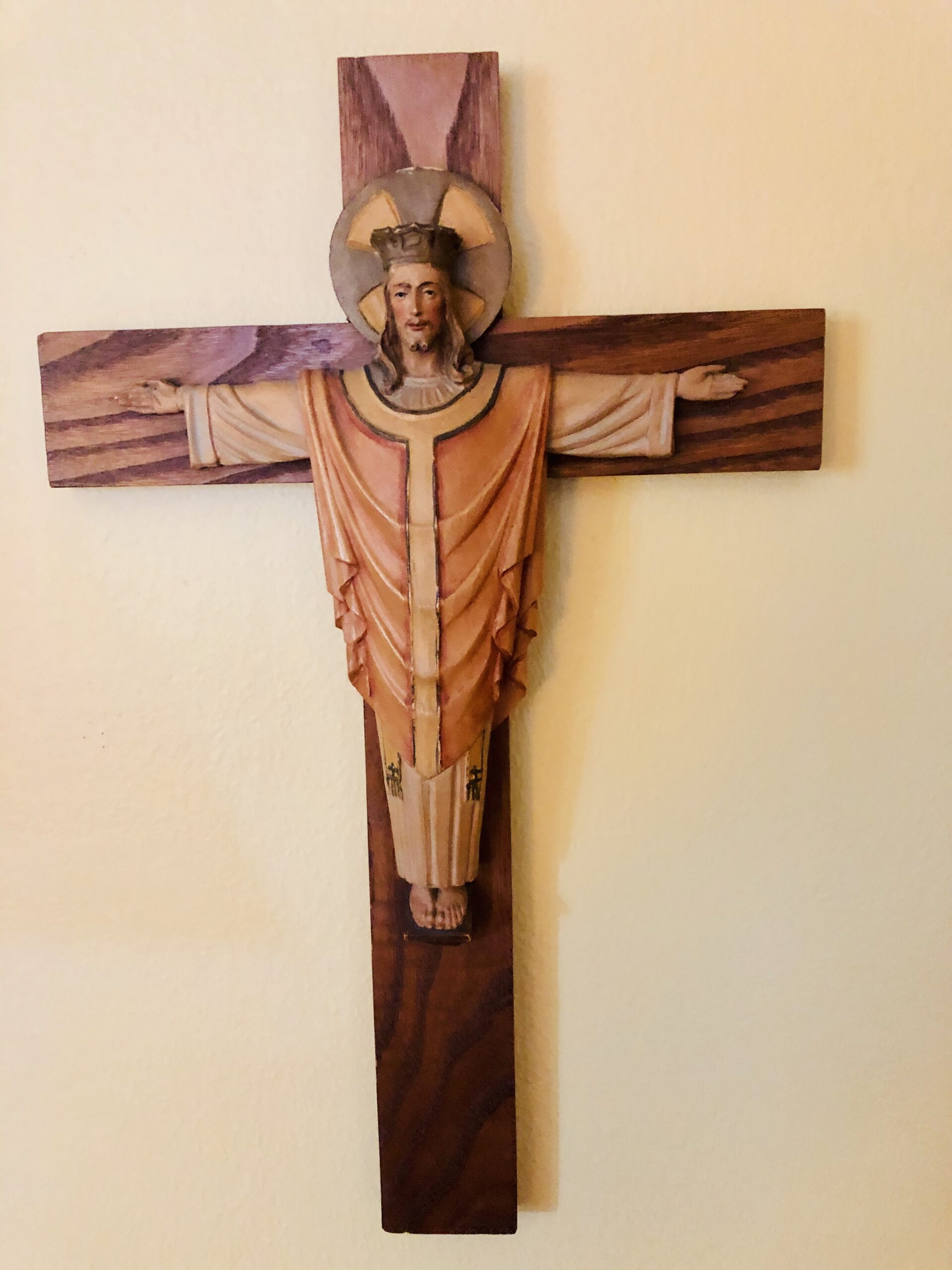
But I take the point. Most images of Christ, at least the ones in Western culture (and here that includes Greece and Byzantium), show Him with white skin. From my “previous life”, I have a beautifully carved Western “Christus Rex” (This is it.) showing Christ the King and High Priest reigning from the Cross. I’m very attached to it. It hangs in my room, and I make the sign of the Cross when I walk past Him. But notice: The Lord here looks like He came from Sweden or somewhere. Jesus’ skin was not white/pink.
A few have argued that Jesus was at least partially black African (an Ethiopian connection): https://www.amazon.com/Jesus-Christ-Negro-Blood-Veins/dp/1651536201 There is no serious evidence for this either. But there are even icons of a black Jesus. You white people, do you find this discomforting, startling, maybe even offensive? Then perhaps you can see why black people take some 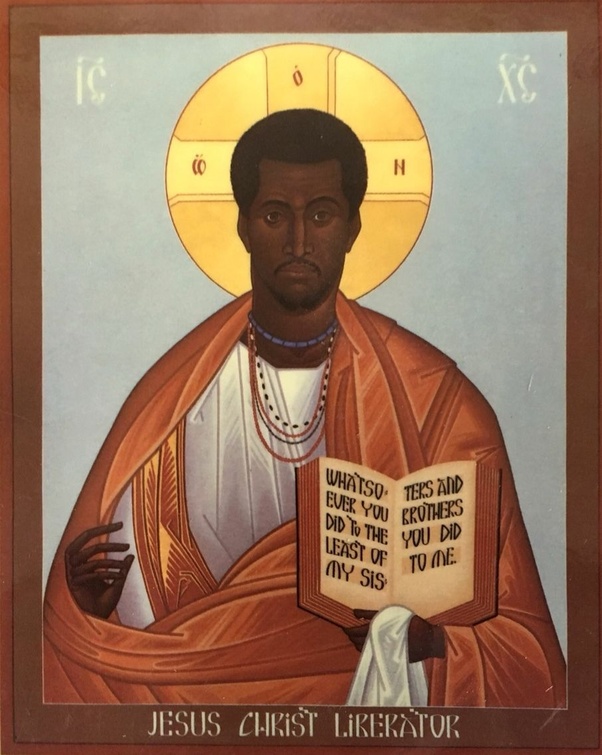 offense at our white Jesus.
offense at our white Jesus.
For neither is accurate. Jesus was brown. He was Semitic, a First Century Middle Eastern Jew. That would likely give His skin an olive shade, but with His face deeply tanned from spending so much time outdoors, walking from place to place. Though He did teach in synagogues, you know His great sermon was given on the Mount. So His skin was brown. His hair and eyes also were dark. I’ve wondered if there’s a way to darken the Lord’s skin on my Christus Rex.
Now, Christians in various places sometimes make images of the Lord Jesus which take on their own characteristics, since He identifies with all of us. Galatians 3:28. Here: Chinese, and from the ancient Irish Book of Kells which shows Him with reddish blonde hair 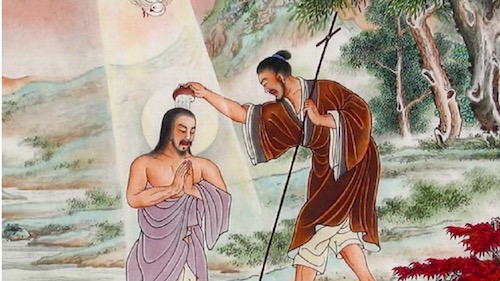 He came to take all human beings into His Kingdom. You can see why we all
He came to take all human beings into His Kingdom. You can see why we all 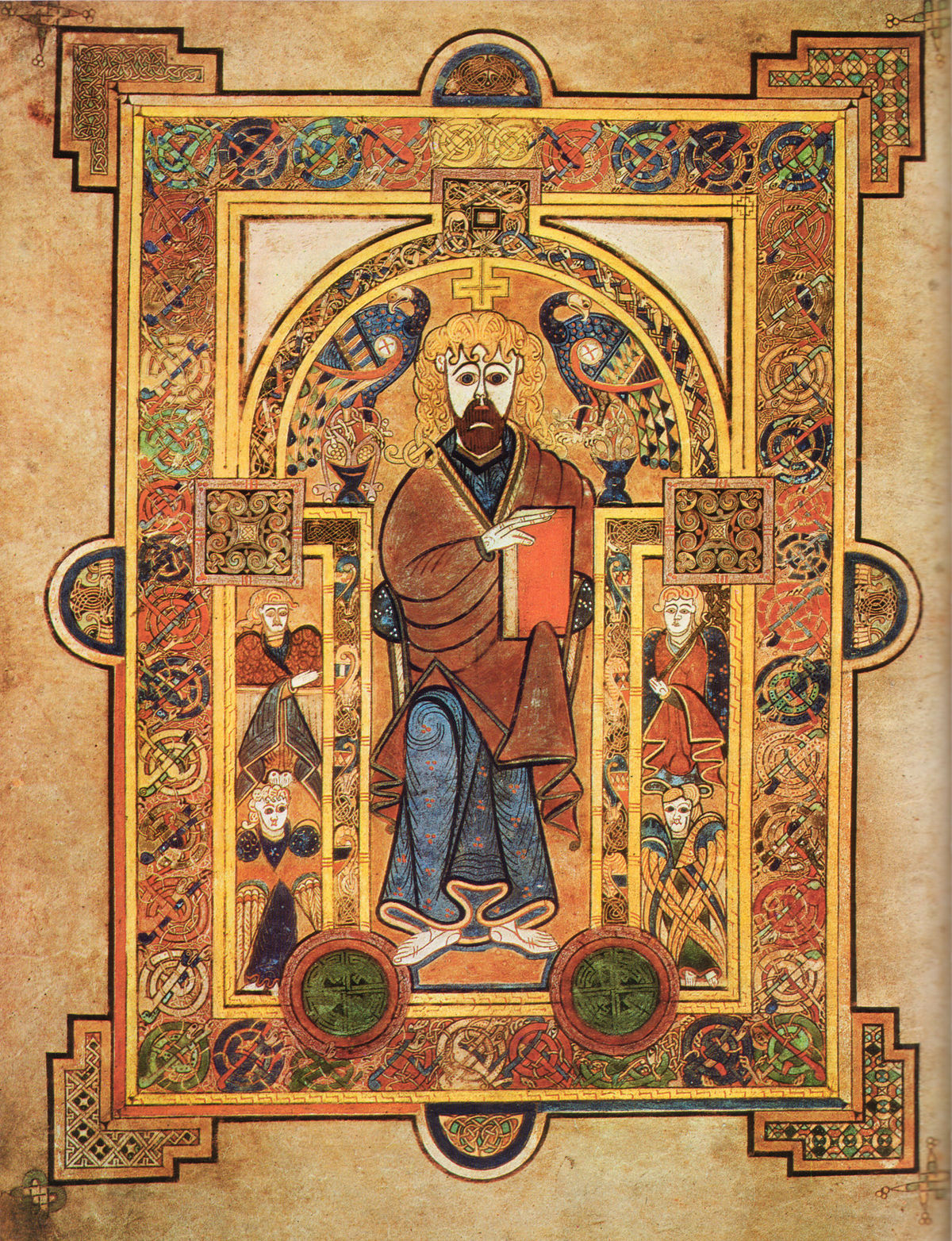 want Him to look like ourselves.
want Him to look like ourselves.
But we need to be extremely careful with this. Jesus Christ was not whoever we might like Him to be. Christ chose to take flesh from a particular Woman in a particular place at a particular time. Jesus was a Middle Eastern Jewish Man.
Below are two images which show more or less what He must have looked like, and in Glory He must somehow still look like this. For He ascended bodily. He is still incarnate.
The first icon is from the Malankara Syrian Orthodox Church of India. The second is found on many sites, but I can’t find the origin.
So if that guy mentioned above had said he wanted to destroy “brown Jesus” and “brown Mary”, we should be all over him. He can’t do that.
But that tells us only about His skin.
Can we know Christ’s personal features, so we could recognize Him?
Obviously not all First Century Jews looked alike. Apparently all men had beards, but what sort of beard did He have? What was the shape of His face? His body?
The Gospels tell us nothing about His bodily appearance.
In the Apocalypse, John saw in a vision the glorified Christ, “The hair on His head was white like wool, as white as snow, and His eyes were like blazing fire. His feet were like bronze glowing in a furnace, and His voice was like the sound of rushing waters. In His right hand he held seven stars, and coming out of His mouth was a sharp, double-edged sword. His face was like the sun shining in all its brilliance.” Revelation 1:13-15 I don’t know what to do with this. John must have seen in this his dearest Friend and Lord Jesus. But If we’re looking for an identifiable image of the Lord, this seems a bit problematic.
So what about the early centuries of the Church? Christians must soon have realized that they were free from the usual Jewish proscription against images – which, just in passing, may not have been as strict as often thought. 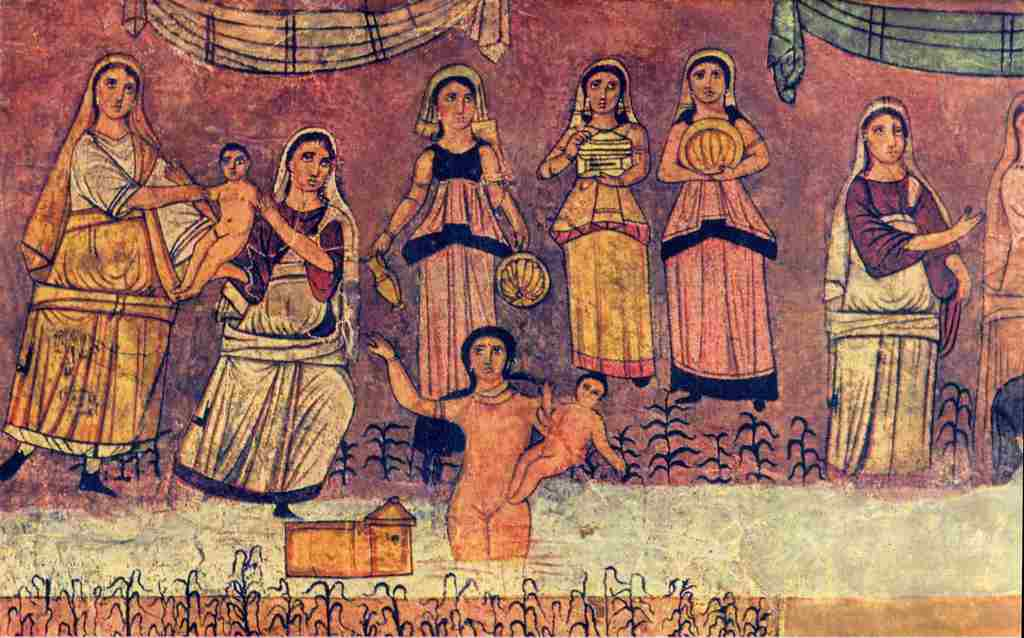 Above is one of many murals from the Dura-Europos synagogue in Syria. This is the Pharaoh’s daughter rescuing Baby Moses.
Above is one of many murals from the Dura-Europos synagogue in Syria. This is the Pharaoh’s daughter rescuing Baby Moses.
Perhaps the earliest images of the Lord are from Syria in the Second Century – which, interestingly, show 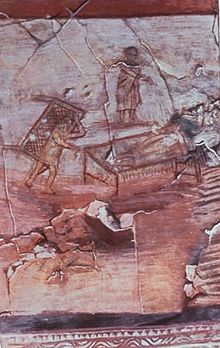 Him as a clean-shaven man, healing the Paralytic.
Him as a clean-shaven man, healing the Paralytic.
Some images of the Lord as a Roman shepherd have been found in the catacombs of Rome.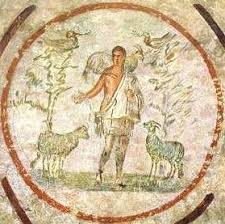
And there are a few more. What can we learn from them about the Lord Jesus’ appearance? Nothing, I think. He definitely didn’t look like that shepherd boy! During times of persecution Christians used symbolic images so that, if the authorities found them, they wouldn’t know Christians had been there.
But then, as soon  as soon as Christians were set free under the Emperor Constantine, permanent identifiable images of Christ quickly appear. Here left is one from Fourth Century Rome which we easily recognize. Were there exceptions? Yes,
as soon as Christians were set free under the Emperor Constantine, permanent identifiable images of Christ quickly appear. Here left is one from Fourth Century Rome which we easily recognize. Were there exceptions? Yes,  right, showing Him beardless healing the demoniac, but apparently not many. Granted, few ancient icons still exist, since Eighth Century iconoclasts destroyed most of them. I’m no expert in art history, so please correct me if this is wrong – but isn’t it accurate to say that the image of Jesus which we still know quickly became the norm. And by the Sixth Century, look! This is from Saint Catherine’s Monastery at Mount Sinai, which the Iconoclasts never got.
right, showing Him beardless healing the demoniac, but apparently not many. Granted, few ancient icons still exist, since Eighth Century iconoclasts destroyed most of them. I’m no expert in art history, so please correct me if this is wrong – but isn’t it accurate to say that the image of Jesus which we still know quickly became the norm. And by the Sixth Century, look! This is from Saint Catherine’s Monastery at Mount Sinai, which the Iconoclasts never got.
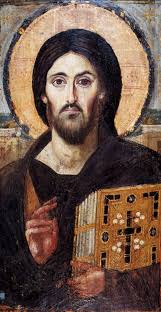
But why the Uniformity?
Consider. Something absolutely remarkable happened here. Or rather didn’t happen. Why didn’t many different images of Christ arise? I’ve read that this is because He was portrayed as a Roman scholar or something. I don’t think so. I mean, why would that suddenly be so popular among Christians everywhere?
And here’s the real question: Even if that were true, how could Christians so quickly have united on one image? I mean, take a hundred artists scattered about without internet, and ask them to draw a picture of someone whom they have never seen, only heard of. What would we get? A hundred different fanciful images. But the Church emerged into freedom, with Christian iconographers quickly writing essentially the same icons of the Lord. Why didn’t one “Jesus” become the norm in Spain, and another in Egypt? Why the uniformity?
For these artists and iconographers were scattered very far apart, through many regions from Ethiopia to Spain, in thousands of parishes. There was no central Church authority to decree that only this one image of Jesus must be used. And even if they had, there was no way to enforce that image on Christian artists. So what could possibly have produced this conformity? Why was it quickly produced all over the Church?
I can imagine only one answer: They must all have been working off one already commonly accepted prototype of the Lord, passed down in the Church from the beginning. And which Christians, with rare exception, all accepted, and still accept today – even if occasionally they get a bit non-traditional and, uh, “pretty”, shall we say?
 Left: Protestant, 1940, Right: Orthodox
Left: Protestant, 1940, Right: Orthodox
Even so, nobody could doubt for a minute who these portray.

But how did it happen?
How could this Image have quietly been passed down for almost three centuries?
Look. 300 years isn’t all that long. When I was younger it seemed like an eternity to me. But now that I’m old and can remember stories my grandparents told about their childhoods nearly 150 years ago, not so long after the Civil War, and I even have some family stories from the time of the Revolutionary War, I think: three centuries – no big deal! And these were only family stories. Think how everything must have been passed on about the Lord and Savior of the world – surely including what He looked like.
Now, all of the above is obviously based only on circumstantial evidence. If you don’t know exactly how Christ’s image was quietly preserved, neither do I. I’m only saying that I think it must have been. Can you think of another reasonable explanation for what happened? If so, please comment below. I’d like to hear it.
For myself, having now thought it through again for this Post, I’m even more convinced that we do know what our Lord Jesus Christ looked like.
But that leaves another question:
What was the Original Image?
The Orthodox Church provides one possible answer.
1 The Mandylion: the “Icon not made by hands”
This is celebrated in the Church every August 16, which is why it came to mind to write about this subject now.
“Mandylion” means towel or small cloth.
Here’s the story.
In Jesus’ time, King Abgar of Edessa (now in southeast Turkey) suffered from leprosy. He heard of this great healer Jesus, so he sent a servant to Israel to ask Jesus to come and heal him. The Lord answered the servant that He was too busy – had only a little time left to complete His work. But 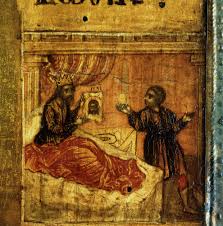 He took a “mandylion”, pressed it to His face, and told the servant to take it back to Abgar, and it would partially heal him. And later He would send someone to heal him completely. When the servant opened the cloth, He saw that on it was an imprint of the face of Jesus. When he returned home, King Abgar (being a king) was less than
He took a “mandylion”, pressed it to His face, and told the servant to take it back to Abgar, and it would partially heal him. And later He would send someone to heal him completely. When the servant opened the cloth, He saw that on it was an imprint of the face of Jesus. When he returned home, King Abgar (being a king) was less than  pleased with Jesus’ answer, but sure enough he was partially healed. After the Resurrection, Christ sent Thaddaeus, one of the Seventy, to Edessa, and Abgar was completely healed.
pleased with Jesus’ answer, but sure enough he was partially healed. After the Resurrection, Christ sent Thaddaeus, one of the Seventy, to Edessa, and Abgar was completely healed.
How authentic is the story? It can’t be documented. Like many extra-Biblical stories of the early Church, it wasn’t written down for a while.
However, it’s worth mentioning that there is a similar story from Acts 19:12, where people are healed by cloths that Saint Paul had touched. And if we can draw out of Roman Catholic tradition: When Our Lady of Guadaloupe appeared in visions to the Mexican peasant Juan Diego, she similarly gave him a cloth pressed to her face with her visage on it. This still exists. The story and miracles of Guadaloupe are well attested, since the Roman Catholic Church in recent centuries has been very cautious about such things.
appeared in visions to the Mexican peasant Juan Diego, she similarly gave him a cloth pressed to her face with her visage on it. This still exists. The story and miracles of Guadaloupe are well attested, since the Roman Catholic Church in recent centuries has been very cautious about such things.
Back to the story of the Mandylion: It was kept in honor 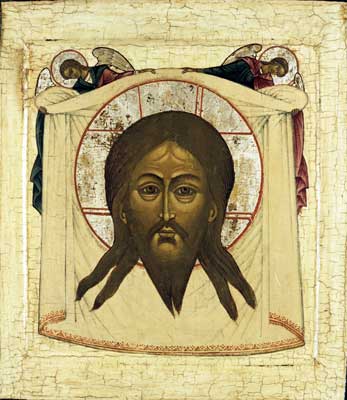 in Edessa till in a time of trouble it was hidden away, then rediscovered and taken to Constantinople. Then the Crusaders hit and – if it wasn’t destroyed as many things were during the sack of Constantinople – Rome says it’s kept in the private Papal chapel in the Vatican. Maybe. Right: a copy thereof
in Edessa till in a time of trouble it was hidden away, then rediscovered and taken to Constantinople. Then the Crusaders hit and – if it wasn’t destroyed as many things were during the sack of Constantinople – Rome says it’s kept in the private Papal chapel in the Vatican. Maybe. Right: a copy thereof
Could this be the source of the The Image of Christ?
2. The Shroud of Turin, said to be the shroud in which the Body of Christ was wrapped for burial, first appeared in Turin Cathedral in Italy, in about the Fourteenth Century. Where it was before that is unknown. Some think Constantinople. Some think nowhere! There is an interesting question: Why did John in his Gospel go out of his way to mention 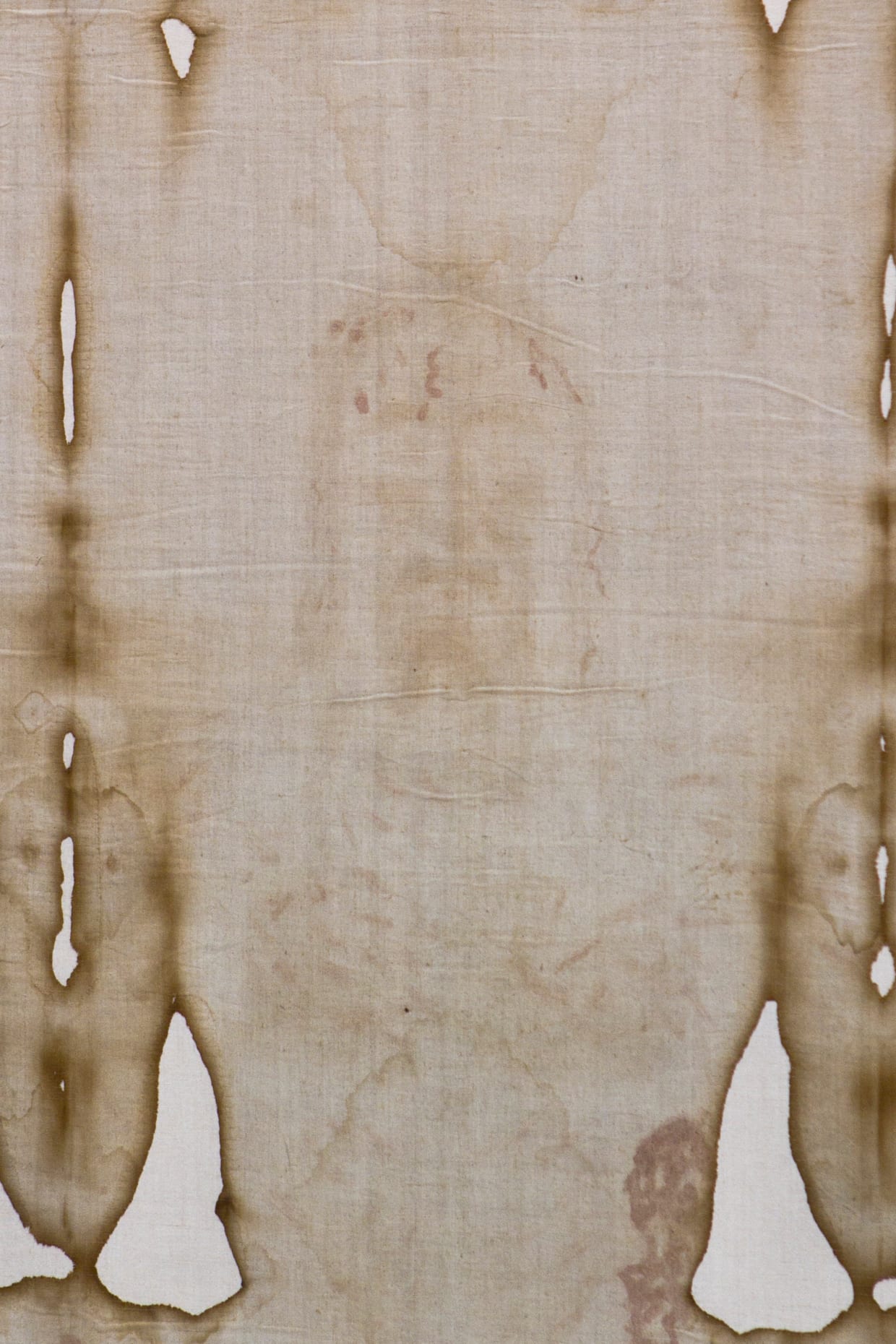 that His grave wrappings were left behind in the tomb? Surely, under the circumstances, the shroud would have been carefully preserved. The image shows a crucified young adult male, with details appropriate to the Gospel description of Jesus’ cruficixion. Some modern tests suggest the image was made in the Middle Ages, others ’round about the First Century. One test found pollen and similar particles appropriate to the First Century Middle East. The image is faint left, but it comes much clearer in a photographic negative. right
that His grave wrappings were left behind in the tomb? Surely, under the circumstances, the shroud would have been carefully preserved. The image shows a crucified young adult male, with details appropriate to the Gospel description of Jesus’ cruficixion. Some modern tests suggest the image was made in the Middle Ages, others ’round about the First Century. One test found pollen and similar particles appropriate to the First Century Middle East. The image is faint left, but it comes much clearer in a photographic negative. right Why ever would such a thing have been made? And how could such an image have been made, given the limitations of medieval technology? So, could it have been created by whatever happened during Christ’s Resurrection? He rose bodily. There must have been a physical process involved, by means completely unknown to mankind. (I’ve always wondered about that.) So… was this the Prototype? or one of them? I find the evidence fairly convincing. Look it up for yourself online, and see what you think.
Why ever would such a thing have been made? And how could such an image have been made, given the limitations of medieval technology? So, could it have been created by whatever happened during Christ’s Resurrection? He rose bodily. There must have been a physical process involved, by means completely unknown to mankind. (I’ve always wondered about that.) So… was this the Prototype? or one of them? I find the evidence fairly convincing. Look it up for yourself online, and see what you think.
3. Veronica’s Veil. This account of how we got the image of Christ is not sanctioned by the Roman Catholic Church, though the event itself 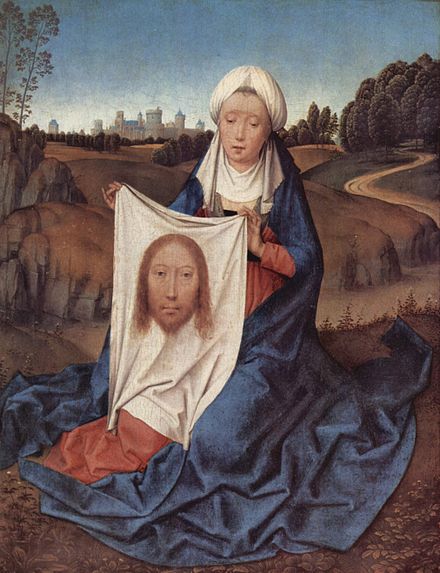 is part of their popular devotion, Stations of the Cross. As it goes, a pious woman Veronica took pity on Christ and pressed her veil to His sweaty face, and His image was imprinted on the veil. The story was not written down till sometime in the Middle Ages.
is part of their popular devotion, Stations of the Cross. As it goes, a pious woman Veronica took pity on Christ and pressed her veil to His sweaty face, and His image was imprinted on the veil. The story was not written down till sometime in the Middle Ages.
Might this have been the Prototype? It seems less likely, I think.
The End
And there we are. What do you think?
The important thing, of course, is not whether we recognize Him, but that in the End He will recognize us.
Till then I guess we’re left with a great mystery.
Or are we?
Next Week: The Trip to Greece that wasn’t, and the Miracle that was
Week after Next: Happy New Year!
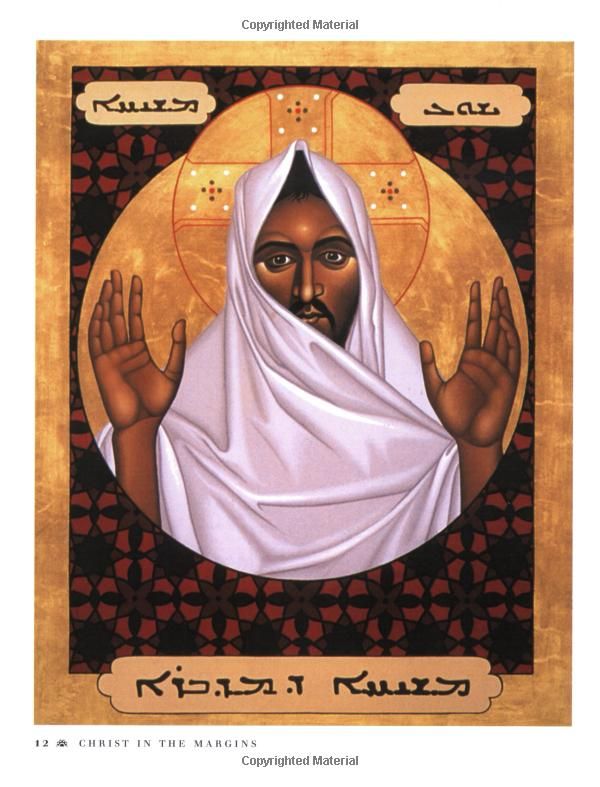
I wonder if Mary the Theotokos had fair hair,though. The idea that all Jews in the Holy Land were olive skinned with black hair is not likely .David the shepherd who because King had fair hair and ruddy skin and the long line of the Lords ancestors proves him to be of the line of David as the Theotokos was also related to that line. Syrians today are often fair of skin and grey eyed.
with brown hair. The Palestinians of the present day were moved to the Holy Land more recently from somewhere near Arabia, I have read, and olive skin with dark hair and eyes have become the norm. during the long Moslem Empires in that region especially the Turkish. Anatolia was not always Turkish either and present day Turkish citizens are not all the Mediterranean types .
I would like to know the original colours of the Sinai ikon as it was painted in wax like the funerary portraits of Roman officials and the portraits of the Emperors taken round the Empire for official display.
I don’t know about the color of Old Testament Jews. Can anyone help us here?
Yes, there was a lot of moving around in the Middle East in times past. I know some Syrians, including some folks from my parish and also our Metropolitan, are light-skinned for that reason. One of our Syrian men recently discovered on Ancestry.com that his people originally came from Georgia. Some of the light skin may also be because of Crusader “involvement”.
However, I think you’d get some argument from the Palestinians about their having “recently” moved to the Holy Land from “near Arabia”. For example, one darkish-skinned man in my parish is from one of some thousands of Palestinian families who are refugees from Ramallah, which was a Palestinian Christian city (though no more, of course) founded in the 1500s. Palestinian Arabs came to the Holy Land from Yemen in about the third century AD.
I watched a talk with Met Jonah and Frederica where she said the Christ of Sinai icon, if overlayed on the Shroud, it matches or lines up on some 100 or 200 (I forget the number) points. In short, the Shroud was the prototype for Christ of Sinai icon.
I inherited a crucifix similar to yours, with Jesus crowned and vested like a priest with a Latin style stole.
Since migrating from the Roman to Byzantine tradition, I’ve lost my taste for the ultra bloody crucifix, and prefer the icon style. (Have you seen the Spanish ones? Yikes! More blood than flesh. I’ll bet Mel Gibson has one of those.)
Thanks for all your work here.
A blessed feast of the Dormition to you, Father! Please remember me and your readers in your prayers.
In a Spanish cathedral which we visited, in a case there was a full-sized greenish gray corpse of John the Baptist – headless with the veins and arteries hanging out. Gaaaa…!
God bless you. And please remember me in your prayers.
On the question, my wife would certainly say “YES”. When she was 5 years old and hiding from her abusive father, there was a beautiful man that came to comfort her. Beautiful brown eyes and sitting on a big golden chair. As a adult she became a Christian, first Episcopal, then RC, then Non-denominational Protestant and then a member of the United Methodist Indian Mission as she is part Native American. She looked for the man on the gold chair, but most importantly the man with the beautiful face and deep, peaceful brown eyes every where she went the man she to this day calls in a 5 year old voice “my Jesus” She did not see Him anywhere until she came with me to her first Orthodox Divine Liturgy and there He was, “Her Jesus” sitting on the gold chair, waiting for her, greeting her. He still greets her and she lights up like a candle and people’s hearts melt, even though they do not know why.
Glory to God!
Glory indeed!
What a strange and beautiful and touching story. Thank you.
I have mixed feelings about “culturally appropriated” images of Christ. On the one hand, they convey a universality about Christ that transcends race. On the other, Christ is not Buddha, who is dust and can be depicted in various styles in East Asian countries because his physical appearance doesn’t exist anymore. Christ still lives and if He did leave an image behind, we should respect that. It’s interesting to see icons done in a Chinese style, but I think they may be closer to interpretive art than iconography. However, I wouldn’t want to step on Paul, who becomes all things to all people so that he might save some. If Chinese or Africans relate to a Jesus that looks like them, maybe that’s a bridge, but it might be more of a breakthrough if they went a step further and thought, “This olive-skinned Jew cares about us, too.” On the third hand, if icons are meant to represent a spiritual reality, then how darkly we shade Christ’s face is probably not so important.
All valid points. Kevin, how many hands do you have?! Are there more to be revealed?
“On the third hand” is an obscure reference to something I read in an economics newsletter. They like to hedge all sorts of possibilities and even three hands aren’t enough. There’s a certain Hindu goddess who should be an economist.
Ha! That reminds me of a funny story about economists I would tell… except that there may be economists here present, so I won’t.
Kevin, just a story: I have a friend, Fr. Moses Berry who is Afro-American. Decades ago before he was Orthodox and still Karl Berry, he was having a tough time continuing to follow Jesus because, as brown as He is, He did not look like an Afro-American, like Karl.
Fr. Moses saw nothing of himself in the face of Jesus.
THEN, an icon of St. Moses, the Ethiopian found its way to Karl. Everything changed. Karl now knew the face of Christ through Abba Moses. There are saints of every ethnic background–God’s garden as Fr. Moses’s grandmother used to talk about.
There is really no need to change the face of Jesus. You are right. But it is done for intimacy and because it is important to see someone who “looks like you”.
Jesus is a particular man who took on a particular human body with a particular DNA mix yet He also took on all of humanity.
Still, as my. wife’s encounters indicate, the appearance of our Lord seems to be accurately depicted by our icons. That is important too. In my wife’s case she knew He looked a particular way and was not at home until she saw Him again. That was a journey of about 50 years.
Thank God for Saint Moses the Black, but I wish we had more black saints in Eastern Orthodoxy. Likely, with Eastern Orthodoxy growing rapidly south of the Sahara, we will soon have more. But for now I wonder: would it be wrong for us to “borrow” some of the many Ethiopian Oriental Orthodox saints and venerate them? There are nineteen pages of them on Orthodox Wiki!
Why would we do that? How would that be different from “borrowing” St. Francis of Assisi or other later Roman Catholic saints because they might have been really nice guys and fill some cultural gap? The decisions of the Councils regarding heresy still remain and venerating anyone who is still in a church under anathema would be a betrayal of Orthodoxy. A monophysite may be less objectionable than an iconoclast, but that doesn’t matter. The ancient Israelites probably looked around at the Caananites and said, “I heard what God told us, but some of these folks are really nice people. I don’t see why we can’t just all live together here.” We know what happened later. This would be questioning the Holy Spirit’s wisdom.
Kevin, I agree that we can’t use post-schism RC saints, except I wish we could sneak Francis of Assisi in quietly. I remember Fr Hopko saying it was a shame that he lived just after 1054 because he was more Orthodox than many Orthodox! With Oriental Orthodox saints, that’s more difficult. But do they compare to Canaanite Baal-worshiping idolaters?! Really? I’m sure you read the Post about the Fourth Council a few weeks ago. Our theologians say that both sides believe the same things about Christ, just have misunderstood and misused each others’ terms. In other respects the Oriental Orthodox are entirely like us: no papal authority, no new dogmas and no missing dogmas. If we wait for our Church “establishments”, will it take another 15 centuries to achieve formal unity? If I have come to read the Orthodox system right, sometimes the people move first and then in time the hierarchs catch up. From what I have heard, most laypeople in the Middle East have already achieved that unity. (Uh oh, am I tempting fate again?)
If it comes down to a linguistic misunderstanding, that presents a real problem. Did the same Holy Spirit Who made the words of the Apostles understandable to people of many languages fail to lead the Church through a language barrier in the Fourth Ecumenical Council? We have to assume that the result of that Council was the will of God because if our Council reached a mistaken conclusion, then Orthodox ecclesiology is broken. If it were a mistake, the Church could have revisited it in the Fifth, Sixth, and Seventh ECs. I don’t know how this gets “fixed” in a way that preserves ecclesiological integrity. The Church has “retconned” someone to be a heretic before, but there was no prior ruling to overturn. I don’t know how it can retcon a declared heresy into not a heresy.
My tentative answer: The words of the Holy Scriptures are inspired and authoritative. However, while translating them into post-Biblical languages, they can be misunderstood and need to be clarified. And of course, no language can be precisely expressed in another.
Likewise the dogmatic decisions of the Fourth Council were inspired and authentic and speak the truth about Jesus Christ – as expressed in Greek. But if some whose native language was not Greek misunderstood, I don’t see how that implies that the decisions of the Council weren’t inspired and correct. And of course then human sin and stubbornness entered in.
I don’t see what the issue is here. Can someone smarter than me explain to me what I’m missing?
https://orthodoxtimes.com/saints-of-africa/
Here is some additional info.
Thanks, Michael. The link you sent is well worth opening.
If we check out Oriental Orthodox material online, I think it’s self-evident that their spirituality is the same as ours – while Roman Catholic and especially Protestant spiritualities usually have a quite different quality and “feel” to them. The Coptic Orthodox in particular have long produced some extraordinarily fine audio-visual materials in English.
Anecdotal, but I’ve met and seen Egyptians more pale and white than me, and I’m Slav/Scandinavian/Irish mix. I always thought it was makeup, but no, truly the complexions were white as snow.
Regarding the comment about how the Mother of God looks, we know very well. Please see the Jerusalem Mother of God icon from Sister Tatiana in the late 19th century and how it came to be.
https://orthodoxwiki.org/Panagia_Ierosolymitissa
Thank you! How did I not know this story?
https://asceticexperience.com/2020/02/saint-paisios-the-athonite-how-jesus-christ-looked-like/